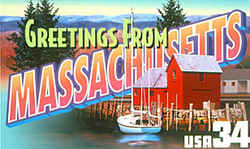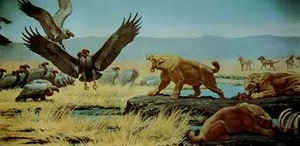
Massachusetts Symbols
Massachusetts State Fossil
Dinosaur Tracks

Adopted on May 23, 1980.
The state legislature declared "dinosaur tracks" the Massachusetts state fossil on May 23, 1980.
The Dinosaur Tracks in Massachusetts, which were made over 200 million years ago. In Granby, the prints of a theropod dinosaur fifty feet in length from head to tail (the first record of a theropod of such magnitude), were found.
There are numerous types of dinosaur tracks found in the sedimentary layers of the Connecticut River Valley . Seven of the more common or more interesting are described briefly below, but there are others . Six of these track types are those of dinosaurs and the seventh was made by an early ancestor of the crocodiles . There are other types of tracks found that do not fit neatly into any of these seven categories of tracks and scientists continue to debate whether they represent distinct footprint types or are simply deformed footprints of these known genera.
Generally, for every inch of track (heel to toe) there is one foot in length of the dinosaur.
Massachusetts State Fossil: Dinosaur Tracks

The Connecticut River Valley of Western Massachusetts is one of the world's richest sources of prehistoric dinosaur tracks, fossilized prints that have yielded important clues to how dinosaurs walked, ran, and lived together. But it is also a hotbed of geological theft. The dinosaur tracks here have been systematically looted over the years as poachers take advantage of their remote location to chip the prints out of rock illegally and sell them to unscrupulous - or unaware - collectors.
The dinosaur tracks in the Connecticut Valley date from about 180 million to 210 million years ago, left in the mud when the valley was a rift in
the ancient supercontinent Pangea. They first came to public attention in the early 1800s, when a 12-year-old farmer's son in South Hadley dug up a
reddish rock that had small, three-toed footprints. The prints were first thought to be the marks of ancient birds, and in the 1830s, the president
of Amherst College, Edward Hitchcock, began cataloging and collecting them, creating an impressive library of prints now in the college's Pratt Museum.
Nearly a century and a half later, his research served as the foundation for a 1972 paper that noted some dinosaurs were probably gregarious and traveled
together, according to Patrick Getty, a graduate student at the University of Massachusetts at Amherst studying dinosaur tracks.
While no one can be certain which dinosaurs made the prints, paleontologists believe the largest - more than a foot in length - may have been made
by Dilophosaurus, a 20-foot-long meat-eater. Many other prints, some made by tiny, cat-sized dinosaurs, are so small they are easy to miss.
The first Dinosaur tracks in North America were discovered in the Connecticut River Valley of Massachusetts.
Dinosaur Track Site and Rock Shop
The first dinosaur tracks in recorded history were discovered by a young farm boy by the name of Pliny Moody
At about age 12, he was plowing a field near Moody Corner, South Hadley, Massachusetts when he discovered a slab of rock with stone tracks on it. It
is said that he then took the slab of tracks home and installed it as a door step at the family home. A few years later, about the time Pliny Moody
went off to school, the tracks were bought by Dr. Elihu Dwight of South Hadley, Massachusetts. Dr. Elihu Dwight was
the first person in recorded history to purchase a dinosaur track. While in the possession of these two men, they obtained the name
"the tracks of Noah's raven" because the biblical Noah, when he was on the ark, released a raven
that never returned. It was believed that the raven landed in South Hadley, Massachusetts and left it's tracks in the mud which later turned to
stone. After obtaining the tracks, Dr. Dwight had the tracks in his possession for about 30 years. About 1839 they where obtained by Professor Edward
Hitchcock for Amherst College. The slab of tracks is known as 16/2 in the Amherst College collection.
Read More....
General Laws of Massachusetts
The law designating the dinosaur track as the official Massachusetts state fossil is found in the General Laws of Massachusetts, Part 1, Title 1, Chapter 2, Section 17
PART I. ADMINISTRATION OF THE GOVERNMENT.
TITLE I. JURISDICTION AND EMBLEMS OF THE COMMONWEALTH, THE GENERAL COURT, STATUTES AND PUBLIC DOCUMENTS.
CHAPTER 2. ARMS, GREAT SEAL AND OTHER EMBLEMS OF THE COMMONWEALTH.
Section 17. The dinosaur track shall be the fossil or fossil emblem of the commonwealth.

Some states that lack a "state fossil" have nevertheless singled out a fossil for formal designation such as a state dinosaur, rock, gem or stone.






